#I'm looking into getting it self published with print on demand and everything but I can't do it through draft2digital because it's fanfic
Explore tagged Tumblr posts
Note
Hello, I'm having a BBC Pride and Prejudice watch party soon with a bunch of my girl friends and just wanted you to know that a) I reread C&C for the occasion and b) I have been recommending it to all my friends as well :)
I read the story incrementally as it was coming out—and enjoyed every chapter!—but binging it was another joy entirely. It reads so nicely: the characters are fleshed out, the scenes you imagined fit right into the narrative's pacing. I simply love everything about Conceit and Conciliation and wanted to tell you so.
THANK YOU! <3
How absolutely lovely of you to come and tell me and thank you for recommending my retelling to your friends!!
It was loads of fun to write, but also so much work to get right, and I'm really happy that it has found its audience <3<3<3
#lovely messages#conceit and conciliation#I'm looking into getting it self published with print on demand and everything but I can't do it through draft2digital because it's fanfic
5 notes
·
View notes
Note
Hello. I know an older person (a relative) who is a very good illustrator (as a hobby). They do have an email address but don't have a website (yet anyway). I'm encouraging them to draw maybe half a dozen or a dozen illustrations so I could submit them to some publishers on their behalf (those who are looking for or open to illustration submissions). Some of these sites mention having a website, others don't. Would the person have to be a professional illustrator or would this be okay? And would it be better for me to see if I can teach them to draw on an iPad or could I just scan on their handdrawn illustrations and email them for them? They're open to the idea but don't think they're good enough. I think they have a lot of natural raw talent, just wondering would publishers be open to illustrations from an older person who is very green to this and has no experience. What do you think? And could you give me/them any other advice? Thank you so much. Happy New Year!
I'd strongly suggest you not do this. I know you have the very best of intentions, and it's lovely that you're such a cheerleader for your relative. I'm sure they are very talented. BUT. Start by finding out what their goals really are. There are plenty of other ways for them to get their work out there. Maybe there are local art classes, where they can explore different mediums and just have fun and meet other artists and potential mentors. Art contests, or local magazines or journals that might publish work from local artists. If they really want to start a little cottage artwork business from home maybe they can create beautiful cards or prints that can be stocked at a local shop or something like that, and you can help them print them out and be their 'sales rep' if you like. Investigate these types of outlets for your relative's creativity, there's no need for their fun and pleasant hobby to become a difficult, demanding career, unless that is something they are TRULY passionate about.
(Not everything needs to be monetized. Normalize just doing things because you like them!)
Because yeah - - you can't really "dabble" in professional book illustration. Either you are a professional illustrator, which means publishers might hire you -- or you aren't, which means they definitely will not. Now, you can be a NEW professional illustrator, that's a thing, people aren't born as professionals -- so, again, if that's really something that your relative WANTS TO DO, truly wants it, OK -- but they are gonna have to do the legwork. You can't be submitting work on their behalf or holding their hand the whole time. Age is not a factor, but professional illustrator is a real job, not a fun-time hobby, and they do have to be willing and able to do the work themselves.
So if becoming a professional children's book illustrator is truly of interest to them, I'd suggest they start by:
-- Taking some picture book illustration classes, whether online or in-person -- specifically those, not just general "art" or whatever. The rules and goals of book illustration are just different from other kinds of art! This is not, strictly speaking, necessary, some artists are indeed entirely self-taught -- but it would probably be QUITE helpful to make them feel more confident (or alternatively, help them realize that this is not where their talent wants to take them!). COST VARIES.
-- They should also read a lot (A LOT) of modern children's books to see what the level of work is that they'd need to be doing, and different ways to tell a story through art. Because it's not just about having pretty images -- that's great, but they have to be able to *tell a story* through the pictures, also, otherwise they have just created random images, not a book. Start with the books that have been Caldecott medalist and honor winners for the past 5 years, they should all be available at your local library. FREE FROM LIBRARY.
-- I'd strongly recommend getting and studying a used or library copy of WRITING WITH PICTURES by Uri Shulevitz. While there is one section that is quite dated (because PB illus are typically delivered digitally now, and this book is from before the digital days) -- the majority of the book, about the actual craft of telling a story through pictures, is super-informative and brilliant. FREE FROM LIBRARY OR UNDER $10. USD
-- Consider joining the SCBWI; it does cost money to be a full member, but if they are serious, it may be worth it -- there are loads of resources online and in person, conferences, local meetups, workshops, etc, where they can connect with other creators and professionals to research and learn the ropes of children's book publishing; there's also a forum where they can ask questions, etc. $99. USD
-- Alternatively (or in addition), there are also kids-book oriented Facebook groups for this kind of thing that have seasoned pros answering newbie questions -- KIDLIT411 would be a smart one to join, if your relative is on Facebook. (Kidlit411 also has a website with resources!) FREE.
Once they have done all these things, they will need a professional-looking digital portfolio -- these can be physical works that are scanned in, or works created digitally (or a combo -- physical works that the artist tweaks layers in photoshop, etc). There are other posts here about what should be included in such a portfolio, look in the FAQ. This way they aren't just sending publishers random images all loosey-goosey, they'll be presenting themselves as somebody that might actually get hired. But I really wouldn't bother with this part until/unless they've done most or all of the previous suggestions.
21 notes
·
View notes
Text
How I designed a new cover for my webcomic's Book 1 reprint
The cover. It's the first impression anyone has of your comic book, so it's got to make an impact. Which is why I'm really proud of the new cover of Heroes of Thantopolis Book 1.
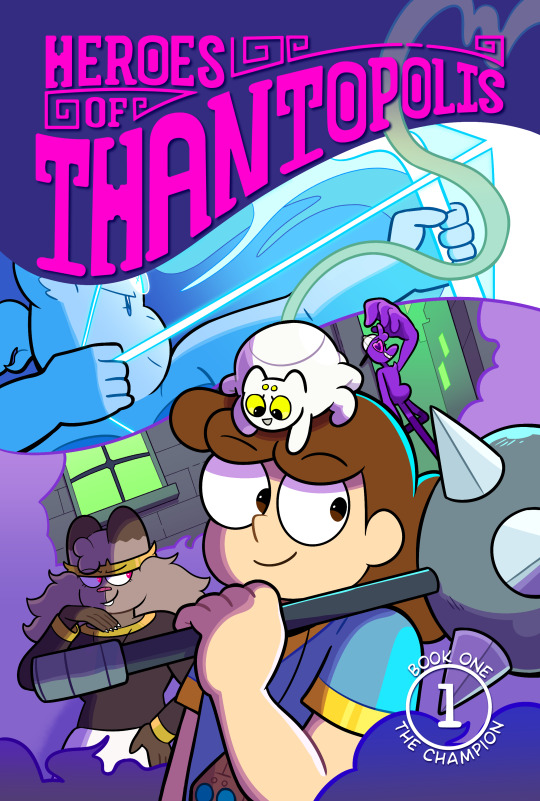
Who are these characters? What kinds of fun and colorful adventures do they get up to? That's what I hope people think when they see the book when it debuts at Cartoon Crossroads Columbus.
But the journey to get to this cover was full of trial and error. Today I want to share that journey and what I learned along the way. Let's go!
The original print cover of Book 1
I self-published the original print of HoT Book 1 in 2016. This was before I joined @hiveworks, and I was using an on-demand printer not really known for their comics, so everything - including the InDesign template I placed the pages in - was done from scratch.
Here's what the cover for the original print looked like:

Helene and Cyrus are front and center amidst tapestries depicting the four chapters of the comic. It's not a bad illustration - not in the slightest! And the comic sold very well at TCAF 2017. But I think you can tell it's an amateur effort. I may have completed four chapters of my comic, but I didn't have comparable experience designing books.
Brainstorming for the reprint
I joined Hiveworks in 2018. Hiveworks has a lot of experience independently publishing webcomics. I planned to re-print Book 1 as well as print the first editions of the rest of the comic under their banner.
I had a good idea of the bonus content I wanted to include in the reprint. I had less of an idea of what I wanted the cover to look like. My first sketches were very movie poster-esque:
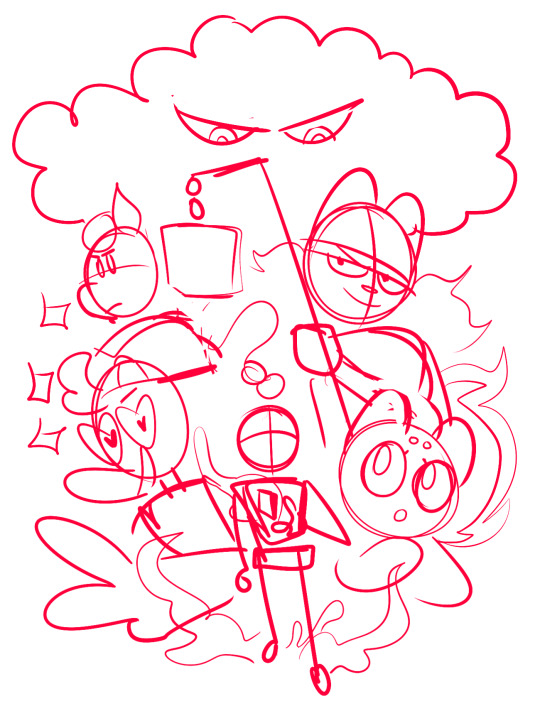

All of the main characters are here, with the villain ominously looming over everyone. It felt like an upgrade from the original cover. But... it felt generic, too. It didn't capture what was unique about my comic.
I put preparations for the reprint to the side for a while, until...
Inspiration
youtube
I love the opening of the Netflix cartoon Hilda. I love the music, the fluid animation and the super cool transitions between her adventures. Hilda goes from riding a dragon to dodging viking warriors, running through the locations and characters she meets during the season. It really captures the vibe of the show!
That's when it occurred to me what was missing from my cover. Readers of Heroes of Thantopolis will know that every chapter has a different color palette, giving them each a unique feel. A unified illustration wouldn't show the diversity of color or feelings. But a cover made of flowing segments, like the Hilda opening...

Now I felt like I was really getting somewhere!
The final cover
Working with my editor Isa (@secondlina), I continued to refine the design of the comic. I wasn't sure what to put in the top left. Isa suggested creating a special version of the logo that flowed along the border created by the Sag segment.
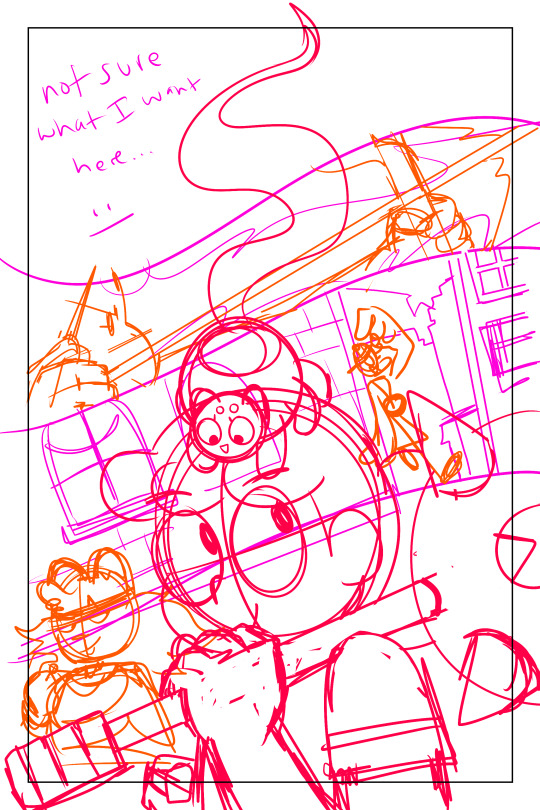
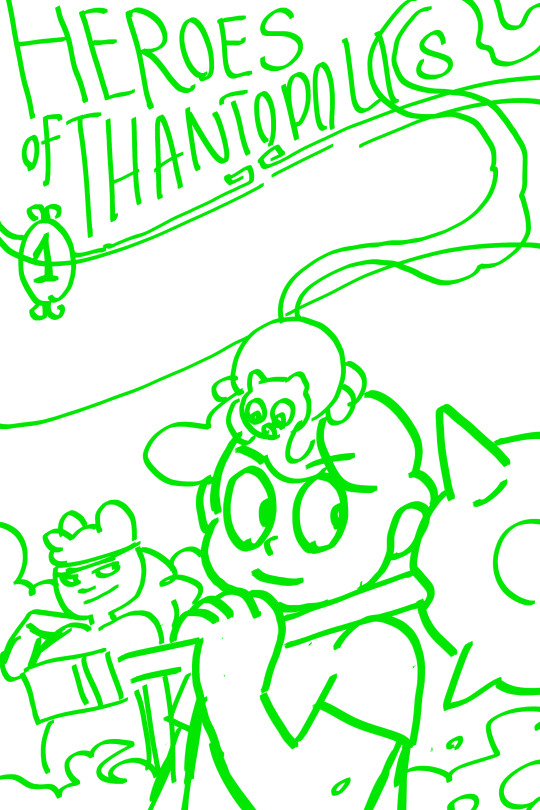
(Isa's sketch in green, on the right)
From there, the final cover began to take shape.
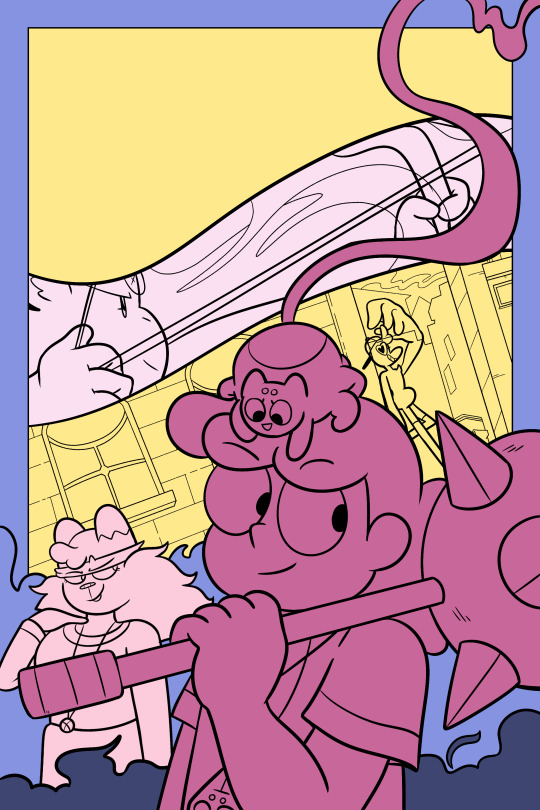

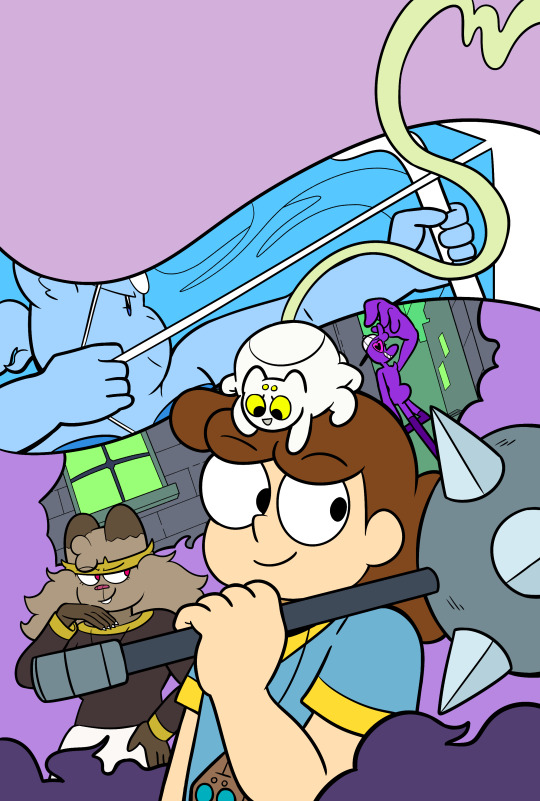
Until we got to the final cover that appears on the actual book!
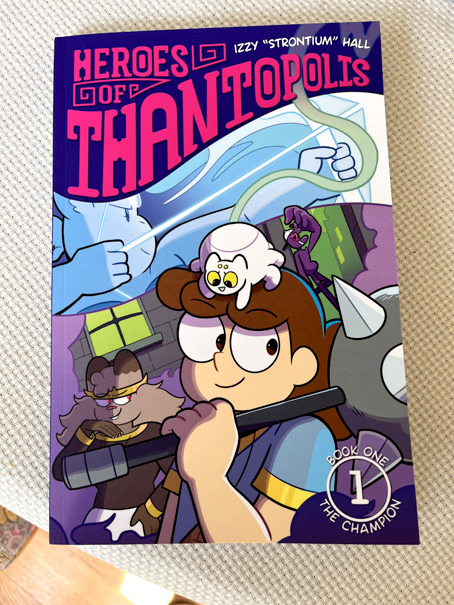
(Print colors are never as vibrant at RGB, but it still captures that colorful vibe.)
Conclusion
If there's one lesson in my creative life that I've seen play out over and over again, it's that your first idea may not be the best idea. Iteration and reflection improves the end result. I'm not saying you need to waffle over every decision. But rather, tp let your creative juices marinade your idea, rather than immediately put the concept to the fire.
I also couldn't have done this without help from people more knowledgeable than I on book design. Not every webcomic creator has access to print experts, true, but there are communities of webcomic creators out there that pool resources and share advice. We can always learn from other people. And that's why I made this post! I hope you enjoyed a peek into my creative process.
I look forward to seeing you at CXC on September 30th and October 1st! If you can't make it to the show, you can read all of Heroes of Thantopolis online, FOR FREE, anytime you want. Book 1 will be sold online soon!
#webcomic#webcomics#heroes of thantopolis#creative process#print comic#printing process#graphic design#cover design#cover art#hiveworks#comic book#Youtube
8 notes
·
View notes
Text
What's the difference?
I read somewhere recently -- although I have no interest in vetting the information -- that about 800 new titles are released every weekday. I met a guy named Steve today who works in publishing. He corrected me. According to Steve, with the combination of traditional, self/indie, and the nebulously defined hybrid publishing paradigms, the number is now more like 4000 every day! (Indies don't have to keep bankers' hour like trads do. "Bankers' hours" -- now there's a rapidly aging phrase.)
So, in an effort to get it straight in my head, I'll just keep writing things down here until someone finds this and corrects me. It's a win-win situation: I'll get some clarity, and you'll get to feel superior for a good 5 minutes.
Traditional publishing -- It's funny that it's called "traditional" because it really only began in the 1860s or so (which doesn't seem that long ago in terms of traditions and all). Before that, the writer, like other artists, depended upon patronage to foot the bills. Once in a while, there might have been a little crowd-sourcing, but basically, it was self-publishing tied to the apron-strings of someone with deep pockets and their own overriding opinions.
Publishing houses developed as a way to facilitate book publishing without the writer being imprisoned or abandoned by the patron's whims. In exchange for the rights to the book, a publishing house foots the bill for the preparation, design, printing, marketing, and distribution of the book. The writer gets royalties AFTER the publisher recoups the costs of preparation, design, printing, marketing, and distribution ... and if the book does well, the costs of reprinting and redistributing, etc. When all is said and done, the writer gets about 10% of the price of the book when it is sold (for the first time). If the publisher gave the writer an advance, that too is made up before those royalty checks start flowin'. The publisher gets to make subsequent decisions about the book because the publisher owns the rights to it. With small presses, it behooves both the publisher and the writer to build and keep a relationship for the sake of future endeavors and profits. With larger presses, there is another layer between them -- the Literary Agent; however, that, my friends, is another post for another day (mainly because I'm just learning about them).
Self-publishing -- is just that. The writer is handles everything -- the preparation (editing mostly), design, printing, marketing and distribution. They get to keep absolute control over these processes. Whether they are any good at them is another story. They may hire people with expertise to help them of course. Mind you, once one pays all those bills and/or calculates the costs of DIY -- after all "time is money" as they say -- the author of the average self-published book makes about 10% on each book sold (the first time, and nothing after it goes to a used bookstore (in case you were confused)). E-books and print-on-demand help with that a lot, but I haven't bothered to look up any stats on that.
Hybrid-publishing -- When a group of people get frustrated with the traditional publishing paradigm and gain some understanding of each step of the self-publishing process, they do some very special machinations to create a bundle of services to offer the writer. This baby is then advertised to writers. The writer gets to keep the rights to their book but pays the hybrid publishing company for each part of this beautiful mysterious journey. Lots of aspects of this relationship can vary widely. Expertise in each step -- editing, designing, printing, marketing, distribution -- needs to be assessed somehow. On one end of the spectrum, it could be wonderfully frank, supportive, and professional -- laying out a realistic plan ... that the writer pays for. On the other end of the spectrum are the "vanity presses." No vanity press will call itself a vanity press. Yes, they offer services. Yes, the writer pays for them. The general business model is the same.
How does one tell the difference? Here are a few red flags that signal a vanity press.
They will print "anything."
They heap praise on you and your writing from Day 1 ... whether they've had time to read your book or not.
They pressure you to sign contracts quickly.
Their pricing structure is vague or full of hidden add-ons. (This is often impossible to assess early enough in the process.)
They avoid officially stating that they adhere to the standards set out by the Independent Book Publishers Association (IBPA), because they aren't concerned about that.
Once one subtracts the cost of the packaged or ala carte services from hybrid publisher from the substantially larger chunk of the sales price the writer receives, it comes down to about ... I dunno. It varies widely depending on the scamminess of the company involved.
Finding a reputable guide though this process takes detective work and research. Thank goodness bloggers about writing and publishing are always so trustworthy and accurate in their posts!
0 notes
Note
hey!! good luck w future endeavours! also: I work at the canadian version of b&n and everything you said is true here too (down to people ‘shocked. like wow! not even in the back?’ that we don’t have a lot of specific things)
Oh, thank you! I really appreciate that (and you, anon!).
Is Indigo equally as bad as Barnes in terms of corporate structure? Let me know. I'm nosy and would love to chat.
Here are things people buying books this holiday season need to know:
- The supply chain is SHIT. Any print on demand books (POD)/self-published books (usually promoted on TikTok: Punk 57, anything Elle K*nn*dy, some Katee Roberts, the Spanish Love Deception, the Atlas Six, etc.) are going to be difficult to get. You WILL have to special-order them; they will not physically be at your chain bookstores, and if they are, it's limited quantity. Because they're self-published and owned by the author, chain bookstores have to pay the author to have them in their stores. BN's current CEO hates POD books and wants them to stop having them in the store (even at the loss of BookTokers' money), and wants them to not be orderable through the BN system. DO NOT TAKE THIS OUT ON THE EMPLOYEES. Also, please note: if your chain bookstores don't have POD books, indie ones might not either. Double also: don't order from fucking Amazon.
- Re: Amazon: Don't fucking order from them. The reason they sell you books at such a low price is because 1) they've bought out all their competitors (look up info about the Amazon/Borders deal) and 2) are making so much other fucking money that they can afford to sell books at a much lower price. You're still just adding to Jeff Bezos' wealth, so you gotta determine whether or not a lower price is worth lining the pockets of a man who refuses to do anything for his employees, who are struggling to make ends meet. Your moral choice.
- If you want a book that's coming out in the near future, at least through February, preorder it now. Printers need to know how much to print. You being a dickhead late on the ball won't help anyone, and will only cause future frustration for you and said printers.
- Order from indie bookstores, not chains like BN. If you want people to have livable wages, you need to force the hand of big companies. BN needs to shell out more money to its staff. BN pays its regular booksellers minimum wage, its lead booksellers $11-13, and its ASMs $16. Not a livable wage. Also, they're all usually trained in the cafe, and aren't given more money for being so.
- No, we don't have it in the back. Everything's fucking out. The panini has hit bookstores hard, and at least my managers wanted everything out on the floor ASAP so we would be fully stocked.
- If you can't find the first edition of a manga on a shelf, it's either been stolen or is out of stock in the warehouses until at least Nov/Dec/Jan/Feb. No, I can't tell you when it comes back in because I don't know.
- BN cafes ARE NOT Starbucks. Please stop asking us to make TikTok drinks. Go to Starbucks. We have basic ingredients.
- For the love of fucking whatever Supreme Being of Choice you believe in, wear your goddamn mask. If I step back from you because you aren't wearing one (and I, a menial employee, am not getting paid enough to fight with you) and you want to show me a book on your screen, don't step closer to me. I do not want you near me.
- Be extra kind to everyone in retail, food service, mail workers, hospitality, and healthcare. We're all so fucking over it. We are exhausted, vastly underpaid, understaffed, and within minutes of screaming bloody murder. At this point, if you scream at me, I will scream back. The customer is not right.
fuck, I'm so tired of this.
#bn#barnes and noble#tbh bn#tbh barnes and noble#b&n#yes come work at b&n you'll cry every day!!!#books#booktok#tiktok#book fandom#book nerd#bookish community#i'm out of barnes on the 17th so here's the tea
1 note
·
View note
Note
I'm curious about the the mental processes that makes torturers do their work. Is that akin to the process that allowed the "Teacher" to press the supposedly shock-inducing button in the Milgram Experiment? Do they blame their victims for "making them torture them"? Does dehumanisation play a role? What do symptoms look like on a torturer? Thank you in advance.
These are all good questions but a lack of research means it’s difficult to answer them definitely.
I’ll start by saying that the Milgram experiments are a steaming pile of… insults to the scientific community shall we say. Honestly as a scientist the Milgram experiments make me angry because they are just so darned sloppy. They are terrible. They cherry picked data. They applied significant coercion to the ‘teachers’ while claiming they didn’t. They failed to record the ways ‘teachers’ tried to trick the system (especially those who pretended to press the button but did not actually do so).
And they also didn’t bother to check whether the ‘teachers’ believed they were actually administering electric shocks. When a follow up study asked these people about it later they found that the majority of people who pressed the button didn’t believe the button caused electric shocks.
Essentially- Milgram can’t tell us shit about why this happens. Those experiments were too sloppy and poorly conducted for us to draw any conclusions.
So what do we actually have that can tell us about torturers?
There are a lot of interviews conducted by non-specialists; mostly journalists. There are works torturers published. I consider both of these sources useful but biased. Torturers have repeatedly shown that they don’t provide accurate accounts of events or their own actions. So – I take these accounts with a pinch of salt and try to be critical.
When it comes to actual specialists providing notes on torturers- I’ve only really found two sources: Fanon’s The Wretched of the Earth contains notes on torturers he treated after the Franco-Algerian war, and Sironi’s body of work studying torturers. Which is only available in French and is print on demand.
Yes I am still bitter, moving on!
Where does all this leave us?
Well it means that we don’t have enough good quality studies to be absolutely sure. It means most of what we ‘know’ is educated guess work, based on the little bit of research and anecdotal accounts.
It’s frustrating. We need more data. And the result is that most of what I can say here is ‘may bes’.
Dehumanisation probably does play a role, but it may not be as great a role as we tend to assume. Studies of the effects of hate speech in Rwanda in the lead-up to the genocide (along with what we know about ICURE techniques) do suggest that dehumanisation makes atrocities more likely. But they don’t necessarily make torture specifically more likely and many torturers will acknowledge the humanity of their victims.
Some torturers do use language that blames their victims but- not in quite the way you’ve put it here. They don’t tend to say victim’s ‘made them’ torture. Instead they tend to suggest that the victims put themselves in a position where they knew they were going to be tortured.
‘A kid that colour walking around in that part of town at night? What did he expect!’
That kind of phrasing is something I see more regularly.
Another common one is torturers suggesting the victims ‘deserved it’ because of a particular characteristic: ie race, sexuality, gender, homelessness, disability. Arguing that a victim was ‘probably guilty’ or is actually guilty of a crime and therefore ‘should’ be tortured is also pretty common among torturers.
But- I also get the impression that most torturers just don’t think about their victims much. Not as human individuals anyway. They don’t seem to consider the lasting impact they have on other people in any meaningful way.
I think this is easiest to illustrate by looking at the way torturers express regret. Because they do often express regret for what they did.
But it’s not expressed as them primarily being sorry they hurt so many people. Instead it’s- they regret what they did because they have nightmares about it. Because they’re ill and the symptoms are terrible. Because they lost their job. Because they’re socially isolated.
It’s regret focused on the consequences of torture for the torturer rather then an acknowledgement of the scale of harm they caused their victims.
I often get asks that suggest this as an inherent characteristic that ‘makes’ people torturers but there’s no evidence to support that. I personally believe this lack of empathy is an effect of torture rather then something that leads to torture.
I guess what I’m driving at here is that there is a rather selfish focus in torturers. But beyond that symptoms in torturers look pretty much the same as symptoms in everyone else.
My impression, based on the interviews I’ve read, is that unless the subject of torture comes up torturers come across as trauma survivors. Asshole trauma survivors but still trauma survivors.
They tend to be rather convinced of their own importance. I’m unsure where this personality trait comes from but it does seem common. It could be a product of the sub-culture torturers create.
And that brings me more or less to- well the answer to the big question here: why do they do it? How can they do it?
My opinion is that the answer has little to do with individuals and everything to do with organisations.
I’ve said it once, I’ll say it again: Torturers do not work alone.
Torture by it’s definition and nature is a function of groups, of broken systems.
Torturers are not individuals who arbitrarily decide to abuse someone. They are police officers with little training and no funding instructed to ‘do something now’. They are soldiers who’ve been taught over a lifetime that the ‘enemy would do the same to us’. They are teachers told to ‘control the class or else’.
They’re groups of people in an environment that has a huge pressure to produce ‘results’ while also being under trained, under staffed, under funded and unsupervised. Into this already unhealthy mix throw the persistent background cultural lie that torture is a short cut to the results they want.
Hell the persistent cultural message that violence is any kind of answer.
Is it really a surprise that our police turn to torture when we don’t teach them to interrogate and our news outlets, our politics, our fiction is full of apologia telling them that abuse will get them the results they want?
The mindset that let’s torturers abuse other people does rely on assumptions that some people are ‘lesser’ or otherwise ‘deserve’ to be abused. But the bit most fiction doesn’t capture is the social aspect.
The way torturers egg each other on and the way they compete. The way they gradually become more or less the entirety of each other’s social circles. The fear they have of each other, which can trap them in the abusive role they’ve taken on. The way they lose other skills, making it feel impossible to switch. The way they seem to feel that stopping represents both personal failure and letting down the only people they still count as ‘friends’.
The closest I’ve seen a movie come to this was The Shape of Water, the villain brilliantly captured the bizarre mix of self importance, incompetence and intense environmental stress that characterises torturers.
Torturers say that they start because ‘there’s no other choice’. I don’t know how much they believe that piece of apologia.
I do know that in any organisation that tortures there is often incredibly intense pressure to participate in, or at least ignore, torture. Refusal often leads to a person leaving an organisation, sometimes feet first.
But the reasons they continue are complicated. For some of them they probably do believe the apologia, that they’re ‘doing necessary work’. Some of them definitely see their victims as less then human.
All of them are caught in a... societal trap not unlike a cult. They’re isolated from non-torturers. They’re constantly fed the message that torturing is right. They’re threatened if they try to leave.
I think that, whether they acknowledge it or not, the main reason torturers continue is because they know they’re at risk if they stop and they know they’ll be completely socially isolated if they stop.
Of course sooner or later they do stop. It’s completely unsustainable.
When they do they generally report isolation, low self esteem and difficulty functioning in society. They struggle to find and keep work. They struggle to form or maintain relationships. It wrecks their lives; the organisation chews them up and spits them out mangled to a point where they can’t navigate society.
And because they rarely come to terms with what they’ve done they rarely recover.
Availableon Wordpress.
Disclaimer
#writing advice#tw torture#writing torturers#torturers#behaviour of torturers#effects of torture on torturers#torture apologia#effects of torture on organisations
244 notes
·
View notes